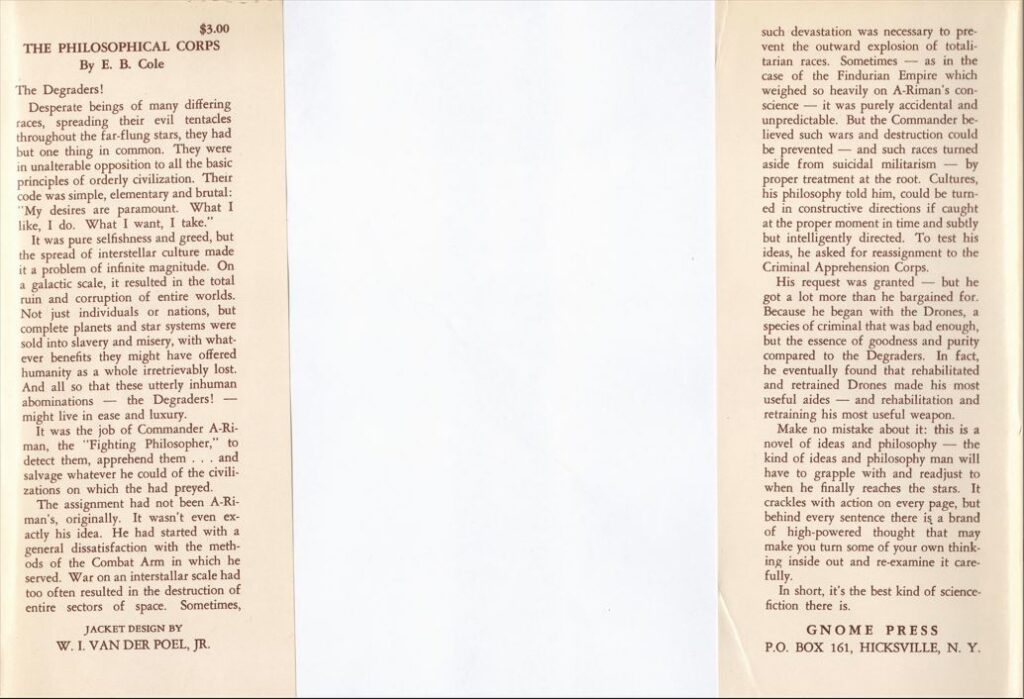Comments
Everett Bush Cole (1910-2001) had a career similar to that of H. Chandler Elliott’s. Both came to science fiction late in life – Cole was 40 when he sold his first story – and not only had full careers outside the field, but were better known for their nonfiction books – Cole’s writing about Texas outpaced this one published novel. He retired at the age of 50, took a degree in math and physics, and spent the next phase of his life in Texas as a high school science teacher, like Hal Clement.
Cole was a career Army man, a veteran of Omaha Beach and later a signal maintenance and property officer at Fort Douglas, UT. He must have had some time on his hands by the early 1950s, because he started selling about a story a year to John Campbell at Astounding throughout the decade and one coda story in Analog in 1970. Starting from the first, about half the stories were sagas of the Philosophical Corps. Three were collected to form this “novel.” The others are “These Shall Not Be Lost” (January 1953); “Millennium” (May 1955); “The Missionaries (May 1956); and “Here There Be Witches” (April 1970). The first three Corps stories chronologically were published as by E. B. Cole, the rest as by Everett B. Cole. Why this novel should bear the older name, less-familiar to contemporary buyers, is inexplicable.
Gnome Notes
This last Gnome Press volume ends the series without quite the embarrassing squalor of the reprinted Fantasy Press volumes. The boards are bound in an attractive light blue cloth. The spine showcases the title between two curving blocks of dark blue ink. The small grace note might be due to Robin Fox, who is credited as the designer. No information at all about him or her can be found.
The dust jacket spoils the package. The front cover is at best an unobjectionable series of coral brushstrokes in lieu of art, courtesy of W. I. van der Poel, Jr. The rear cover is an awesome assemblage of weird typos, odd mistakes, and silly inconsistencies. I discuss it at length in The Back Panels.
It hardly matters. There’s little evidence that anyone ever saw the book at the time, despite Greenberg again insisting that all 4000 copies were bound and distributed. The copyright is given as 1961, but only one f&sf magazine bothered to review the novel and that wasn’t until 1963. No newspaper reviews either, that I can find. The first mention of the book is a library acquisition on June 15, 1962. A Pick-A-Book ad that started running in the February 1961 issue of Analog mentions it, along with 1961’s Invaders from the Infinite but not 1961’s Grey Lensman. The 1961 Pick-A-Book catalog says it will be forthcoming in May, two months after Invaders, which really was published right on time. The actual publication date in unknown and throwing a dart at a set of 60’s calendars would provide better results than research. The ISFDB says “Reginald1 and Clute/Nicholls have 1961, Tuck and Contento have 1962.” ESHBACH and KEMP agree with 1962. Yet, the Library of Congress Catalog Card Number has “60” as a date prefix. The title doesn’t appear in the Catalog of Copyright Entries until the January-June 1965 edition. The registration date there is 10Dec62 but also states “in notice: 1961.”
In a near-impossible stroke of luck, I picked up a piece of physical evidence that would seemingly settle the issue: a copy of the book containing the original review slip. The publication date is set as “Sep 15 1962.” Only one thing keeps that from being definitive, the library acquisition of the book three months earlier. (A second earlier one can also be found.) On the one hand, while review copies normally go out shortly after printing, no rule prohibits a later mailing to someone who asks for the book. On the other, if the book was already published and available why wouldn’t the review slip reflect that date or leave the date off entirely as other review slips did? Just like Gnome to compound a mystery by providing evidence. In either case, I’m compelled to conclude that the year of publication is 1962.
Reviews
P. Schuyler Miller, Analog Science Fact • Science Fiction, April 1963
This is the kind of interplanetary action fiction that is simply good fun to read. We need more of it.
Contents and original publication
• Chapters 1-6 (rewritten from Astounding Science Fiction, April 1954, as “The Fighting Philosopher”).
• Chapters 7-10 (rewritten from Astounding Science Fiction, March 1951, as “The Philosophical Corps”).
• Chapters 11-21 (rewritten from Astounding Science Fiction, April 1955, as “The Players”).
• Chapter 22 (original to this volume).
Bibliographic information
The Philosophical Corps, by E. B. Cole, 1962, copyright registration date 10Dec62, Library of Congress Catalog Card Number 60-53081, title #86, back panel #42, 187 pages, $3.00. 4000 copies printed. Hardback, light blue cloth with dark blue lettering and blocks of ink on spine. Jacket design by W. I. Van der Poel, Jr. “First Edition” on copyright page. Manufactured in the United States of America, by H. Wolff, New York. Designed by Robin Fox. Back panel: 27 titles.Gnome Press address given as P.O. Box 161, Hicksville, N. Y.
Variants
None known.
Images





